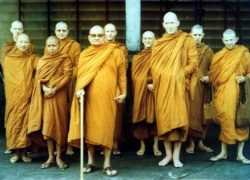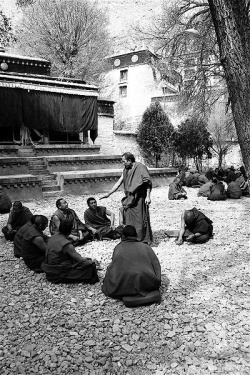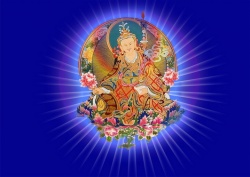Numerical Dharmas (doctrinal lists)
Buddhism was originally memorized and recited verbatim without being written down. To facilitate this oral tradition, many "lists" were developed. They are compact statements that are then unfolded and expounded on. Of course, for some it became dogmatic: there are this many; this is what the Buddha taught; this is the only right view, and all other views are wrong. In fact, the lists are flexible and only a device. The Buddha himself listed sets of things in different ways according to what he was emphasizing.
For example, in one sutra (Satipatthana) the Four Noble Truths are left out, and in another version they are included (Mahasatipatthana). No one doubts that these central teachings are crucial. But according to circumstances they are not mentioned in one context yet mentioned in another. The Noble Eightfold Path can easily be expanded to ten without changing anything but the way things are labelled. (This happens with the Ten Precepts becoming Eight Precepts by reshuffling;
see; sikkhapada).
All of this is taken to the extreme in lists and lists of Buddhist lists. The point is not to become attached to lists or to the belief that there's something magical in the number of things enumerated. Any list is simply a handy way of teaching and remembering the Dharma, which is a vast body of information. With that in mind, here are some traditional formulations:
UNIQUE
There is only one unique situation where suffering (dukkha) is eliminated. It is nirvana, which is without geographical location. It is there that the four primary elements find no footing whatsoever.
TWOFOLD
Two chief male disciples: Thera Sariputta and Thera Moggallana
Two chief female disciples: Theri Khema and Theri Uppalavanna
Two seven-year-old arhats (enlightened ones) were the novices (samaneras) Sumana and Pandita (Dhammapada V. 382 & V.80)
Two kinds of happiness (sukha) are bodily (kaya) and mental (citta).
Two foremost teachers are mother and father.
Two kinds of personality-view (sakkaya-ditthi) are
(1) taking delight in individuality (sakkaya-bhirata) and
(2) striving towards cessation of mental and material phenomena (nirvana-bhirata).
Two kinds of individuals; (bhirata) with distorted perception are those who hold either to eternalism (sassata) or annihilationism (uccheda).
Two persons whom one can never pay back the debt of gratitude in full are mother and father who raised one.
Two principles guarding the world (lokapala dhamma) are conscience (hiri) about harming and dread (ottapa) of consequences about doing harm.
THREEFOLD
Tipitaka (Three Baskets) of Buddhism: Discourses (sutras), Disciplinary Code (Vinaya), and Higher Teachings (Abhidharma)
Three kinds of bodhisattva (those destined to become a buddha):
(1) Intellectual, those fulfilling the Ten Perfections (parami) for four incalculable periods (asankheyyas) and 1,000 aeons (pannadhika-bodhisatta);
(2) Devotional, fufilling the perfections with conviction (saddha) for eight incalculable periods and 100,000 aeons (saddhadhika-bodhisatta;
(3) Energetic, fulfilling the perfections with endeavour predominating for 16 incalculable periods 100,000 aeons (viriyadhika-bodhisatta).
Three kinds of Dispensation (sasana):
(1) learning the Buddha's Teaching (Pariyatti Sasana);
(2) practical application of the Buddha's Teaching (Patipatti Sasana);
(3) the realization of the Buddha's Teaching (i.e., attainment of jhanas, paths, fruitions, and nirvana (Pativedha Sasana).
Three types of Essence: generosity (dana), virtue (sila), and insight (vipassana).
Three characteristic marks or signs inherent in all sentient existence: impermanence (anicca), unsatisfactoriness (dukkha), and impersonal [uncontrollable] nature (anatta) of things.
Three kinds of attachment to existence (raga): in the sensuous sphere; in the fine-material sphere, and in the immaterial sphere.
Three categories of monastics: Elders (thera), those who have spent ten or more years in the Order; those of middle standing (majjhima), who have been in the Order from five to nine years; newly ordained ones (nava), who have been in the Order for less than five years.
Three kinds of craving (tanha): attachment to sense pleasures (kama-tanha); attachment to continued existence (bhava-tanha); attachment to views that karma entails neither rebirth nor future existence (vibhava-tanha).
Three Disasters (kappas): by famine, weapons, or epidemic.
Three Worlds (lokas): conditioned world (sankhara-loka), corporeal world (satta-loka), inanimate world (okasa-loka).
Three Supermundane Dharmas: paths (magga) and fruitions (phala) [entering the path to the four stages of enlightenment -- stream-winning, once-returning, non-returning, and arhatship -- and attaining each stage; nirvana (nibbana) [the ninth supermundane Dharma or Ultimate Truth as distinct from mundane states of consciousness].
Three kinds of Training (sikkha): in virtue or morality (sila), concentration or collectedness (samadhi), wisdom or understanding (panna).
FOURFOLD
Four Netherworlds (apayas): the realms of intense continuous suffering (hells, niraya); animal realms (tiracchana); hungry ghost realms (peta); realm of miserable beings (asurakaya).
Four Analytical Insights (patisambhidas): insight into the true meaning and consequence of things (atthapati-sambhida); insight into the nature of the Dharma (dhamma-patisambhida); insight into the meaning, grammar, and syntax of the language (nirutti-patisambhida); insight into the nature of these three knowledges (patibhana-patisambhida).
Four Intoxicants (stains, cankers, corruptions, or asavas):
(1) attachment to sensual pleasures (kamasava);
(2) attachment to material and immaterial meditative states and their corresponding states of existence (bhavasava);
(3) holding [62 kinds of] false views (ditthasava);
(4) ignorance with regard to the Four Noble Truths, past and future lives, and the Law of Dependent Orignation (avijjasava).
Four Attributes of Nirvana: it is expounded by a fully enlightened buddha (sammasambuddha desitam); free of sorrow (asokam), free of corruptions (virajam); peaceful (khemam).
Four Sublime Abidings (Brahma Viharas): loving kindness, compassion, sympathetic joy, equanimity.




